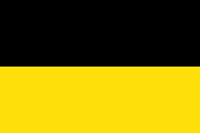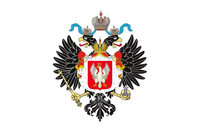World War I (1914-1918)

Battle of Galicia
The Battle of Galicia, also known as the Battle of Lemberg, was a major battle between Russia and Austria-Hungary Austria-Hungary, often referred to as the Austro-Hungarian Empire, the Dual Monarchy, or Austria, was a constitutional monarchy and great power in Central Europe between 1867 and 1918. Austria-Hungary was one of the Central Powers in World War I, which began with an Austro-Hungarian war declaration on the Kingdom of Serbia on 28 July 1914. during the early stages of World War I in 1914. In the course of the battle, the Austro-Hungarian armies were severely defeated and forced out of Galicia, while the Russians
Austria-Hungary, often referred to as the Austro-Hungarian Empire, the Dual Monarchy, or Austria, was a constitutional monarchy and great power in Central Europe between 1867 and 1918. Austria-Hungary was one of the Central Powers in World War I, which began with an Austro-Hungarian war declaration on the Kingdom of Serbia on 28 July 1914. during the early stages of World War I in 1914. In the course of the battle, the Austro-Hungarian armies were severely defeated and forced out of Galicia, while the Russians Russian Empire was an empire and the final period of the Russian monarchy from 1721 to 1917, ruling across large parts of Eurasia. The rise of the Russian Empire coincided with the decline of neighbouring rival powers: the Swedish Empire, the Polish–Lithuanian Commonwealth, Qajar Iran, the Ottoman Empire, and Qing China. Russia remains the third-largest empire in history, surpassed only by the British Empire and the Mongol Empire. captured Lemberg and, for approximately nine months, ruled Eastern Galicia until their defeat at Gorlice and Tarnów.
Russian Empire was an empire and the final period of the Russian monarchy from 1721 to 1917, ruling across large parts of Eurasia. The rise of the Russian Empire coincided with the decline of neighbouring rival powers: the Swedish Empire, the Polish–Lithuanian Commonwealth, Qajar Iran, the Ottoman Empire, and Qing China. Russia remains the third-largest empire in history, surpassed only by the British Empire and the Mongol Empire. captured Lemberg and, for approximately nine months, ruled Eastern Galicia until their defeat at Gorlice and Tarnów.
Background
When war came the Austro-Hungarian Chief-of-Staff Franz Conrad von Hötzendorf planned to launch an offensive into Russian Poland Congress Poland, Congress Kingdom of Poland, or Russian Poland, formally known as the Kingdom of Poland, was a polity created in 1815 by the Congress of Vienna as a semi-autonomous Polish state, a successor to Napoleon's Duchy of Warsaw. It was established when the French ceded a part of Polish territory to the Russian Empire following France's defeat in the Napoleonic Wars. In 1915, during World War I, it was replaced by the German-controlled nominal Regency Kingdom until Poland regained independence in 1918. with his northern armies (the 1st and 4th). The Russians would far outnumber the Central Powers in the east (especially the Austro-Hungarian armies, which were Russia's primary target), Conrad believed that their best option was an early advance into southern Poland where the Russians would be concentrating their newly mobilized units.
Congress Poland, Congress Kingdom of Poland, or Russian Poland, formally known as the Kingdom of Poland, was a polity created in 1815 by the Congress of Vienna as a semi-autonomous Polish state, a successor to Napoleon's Duchy of Warsaw. It was established when the French ceded a part of Polish territory to the Russian Empire following France's defeat in the Napoleonic Wars. In 1915, during World War I, it was replaced by the German-controlled nominal Regency Kingdom until Poland regained independence in 1918. with his northern armies (the 1st and 4th). The Russians would far outnumber the Central Powers in the east (especially the Austro-Hungarian armies, which were Russia's primary target), Conrad believed that their best option was an early advance into southern Poland where the Russians would be concentrating their newly mobilized units.
Conrad knew that his German The German Empire, also referred to as Imperial Germany, the Second Reich, as well as simply Germany, was the period of the German Reich from the unification of Germany in 1871 until the November Revolution in 1918, when the German Reich changed its form of government from a monarchy to a republic. During its 47 years of existence, the German Empire became the industrial, technological, and scientific giant of Europe. allies were committed to an offensive in the West to defeat the French in the first ten weeks of the war. Only the German 8th army would be in the East, where they would stand on the defensive in East Prussia. However, their alliance with the French
The German Empire, also referred to as Imperial Germany, the Second Reich, as well as simply Germany, was the period of the German Reich from the unification of Germany in 1871 until the November Revolution in 1918, when the German Reich changed its form of government from a monarchy to a republic. During its 47 years of existence, the German Empire became the industrial, technological, and scientific giant of Europe. allies were committed to an offensive in the West to defeat the French in the first ten weeks of the war. Only the German 8th army would be in the East, where they would stand on the defensive in East Prussia. However, their alliance with the French French Third Republic was the system of government adopted in France from 4 September 1870, when the Second French Empire collapsed during the Franco-Prussian War, until 10 July 1940, after the Fall of France during World War II led to the formation of the Vichy government. During the 19th and 20th centuries, the French colonial empire was the second largest colonial empire in the world only behind the British Empire. obliged the Russians to attack the Germans promptly, so substantial Russian forces would be sent to invade East Prussia. The 1st and 4th Austro-Hungarian Armies would advance into Poland without direct German support. By 23 August 1914 Conrad's 1st, 3rd, and 4th Armies were concentrated in Galicia along a front of 280 km (170 mi).
French Third Republic was the system of government adopted in France from 4 September 1870, when the Second French Empire collapsed during the Franco-Prussian War, until 10 July 1940, after the Fall of France during World War II led to the formation of the Vichy government. During the 19th and 20th centuries, the French colonial empire was the second largest colonial empire in the world only behind the British Empire. obliged the Russians to attack the Germans promptly, so substantial Russian forces would be sent to invade East Prussia. The 1st and 4th Austro-Hungarian Armies would advance into Poland without direct German support. By 23 August 1914 Conrad's 1st, 3rd, and 4th Armies were concentrated in Galicia along a front of 280 km (170 mi).
On 2 August Grand Duke Nicholas Nikolaevich, a second cousin of Emperor Nicholas II who had made his career in the army, was made Commander-in-Chief. He had an excellent reputation for training troops, but had never commanded a field army and was staggered by his unexpected elevation. The Russian 3rd, 4th, 5th, and 8th Armies were assigned to Galicia. The Russian war plan called for Nikolai Ivanov, the Russian commander of the Southwest Front, to counter an anticipated Austro-Hungarian offensive thrusting eastward from Lemberg. The 3rd and 8th Armies would mount an offensive into eastern Galicia. The Russians could bring 260 trains a day to their front, compared to the Austro-Hungarian's 152.
Battles
The Austro-Hungarian 1st Army under Viktor Dankl was moving in the north towards Lublin. Dankl struck and drove back Baron Salza's Russian Fourth Army in what would be known as the Battle of Kraśnik. Dankl's army was able to capture 6,000 prisoners.
To the right of Dankl the Austro- Hungarian 4th Army, aiming at Cholm, drove back the Russian Fifth Army under Pavel Plehve in the Battle of Komarów, capturing 20,000 prisoners and inflicting heavy casualties. However, a planned Austrian enveloping movement around the Russian army failed.
As the Russians were being driven back along the northern front, the Austrian 3rd Army and Army Group Kovess made a simultaneous advance against Ivanov's left wing. Along the southern front, Ivanov had the Russian Third Army under Nikolai Ruzsky and the Russian Eighth Army under the capable Aleksei Brusilov. Brusilov and Ruszky routed the Austro-Hungarians so thoroughly that even though poor roads necessitated that the Russians halt for two days, the Austrians could not regroup to halt the Russian drive. This attack became known as the Battle of Gnila Lipa.
With the entire 3rd Army and Kovess Group in full retreat, Conrad pulled forces away from the northern front which he believed had been sufficiently defeated. In fact, the Russians north of Lemberg were still a potential threat. Ivanov ordered Plehve's Fifth Army to attack and drove the Austrians back as they began to shift forces to the south in an engagement known as the Battle of Rava Ruska. The Austrian Second Army was quickly recalled from Serbia, but it was too late and the entire Austrian front collapsed in Galicia, and the Russians took control of Lemberg.
Results
As the Austrians retreated many Slavic soldiers in the Austro-Hungarian Army simply surrendered and some even offered to fight for the Russians. Holger Herwig estimates Austro-Hungarian losses of 100,000 dead, 220,000 wounded and 100,000 captured. According to Prit Buttar, the Austro-Hungarian army lost 324,000 men in Galicia, including 130,000 as prisoners, while the Russians lost 225,000 men, of which 40,000 were captured. Other authors estimate 400,000 Austro-Hungarian losses, or "one-third of the Austro-Hungarian Army's combat effectives", and 250,000 for the Russians.
The Russians had pushed the front 160 kilometers (100 miles) into the Carpathian Mountains, completely surrounded the Austrian fortress of Przemyśl and started a Siege of Przemyśl which lasted for over a hundred days. The battle severely damaged the Austro-Hungarian Army, destroyed a large portion of its trained officers, and crippled Austria. Though the Russians had been utterly crushed at the Battle of Tannenberg, their victory at Lemberg prevented that defeat from fully taking its toll on Russian public opinion.
HISTORY

RESOURCES
This article uses material from the Wikipedia articles "World War", "World War I", and "Battle of Galicia", which is released under the Creative Commons Attribution-Share-Alike License 3.0.
© Stories Preschool. All Rights Reserved.










